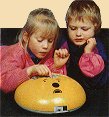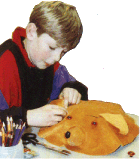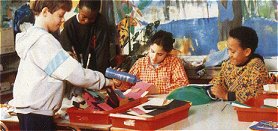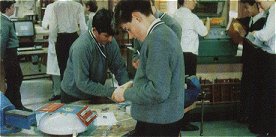
|
Feedback Form
| Introduction | Design | Ideas | Design & Control |
Project Suggestions |
Roamer as a Design Medium
The Roamer was developed to provide a creative medium for children to explore design. Its shape allows the creation of a host of robot characters. These can be a mix of reality and fantasy, of technology and imagination. Developing Roamer characters can be a rewarding educational activity in which the child encounters all elements of the design process: Design Brief, Design, Manufacture and Testing.
Characterisation can also be a catalyst for activities like creative writing, programming, art, crafts and mathematics.
 |
 |
| CLEOPATRA (History) |
SHERLOCK HOLMES (Fiction/Literature) |
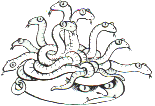 |
 |
| MEDUSA (Mythology) |
AMERICAN FOOTBALLER (Sportsworld) |
things: Romeo and Juliet, Kermit the Frog, Madonna, Thomas
the Tank Engine, Long John Silver, Cinderella...
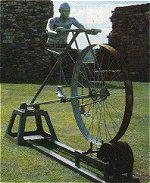 Robots
fascinate children, they love playing and working with them. Their designs
can be simple characters made with the Roamer Face Shapes or sophisticated
robots using the Roamer control features. By providing a design challenge
that can grow with the child's age and ability, Roamer furnishes a link
that can be maintained throughout the school years.
Robots
fascinate children, they love playing and working with them. Their designs
can be simple characters made with the Roamer Face Shapes or sophisticated
robots using the Roamer control features. By providing a design challenge
that can grow with the child's age and ability, Roamer furnishes a link
that can be maintained throughout the school years.
Creating a Roamer character is like creating a mechanical sculpture: "Cycling to Work" by John White. (See photo on right)
Unfortunately much technology reinforces unhealthy gender and racial stereotypes. Roamer was purposely developed to combat this problem by appealing to girls or boys of various cultural backgrounds.
Creating a Roamer character is not an exercise in copying images. It's about depicting the essence of the subject. The Roamer mouse is a robot living in its own world. Mice in Roamerworld do not need to look like 'real mice'. Creation of Roamer characters involves the development of appearance, environment and behaviour.
The fantasy element in characterisation helps to nurture a free-thinking approach to design. And by using the Design Process the student also develops the practical disciplines of the professional designer.
The Roamer fits in well with work across the curriculum and encourages children to appreciate design in the world about them. Design and education prosper in creative environments. The Roamer has a unique place in both.
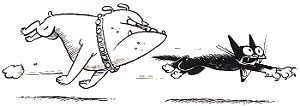
Cartoonists use artistic licence but still depict
the essence in
their drawings. This approach is the key to Roamer design work.
The Valiant Roamer Design Handbook
The Handbook is for teachers of children of all ages and abilities. It will be of special interest to Art, Craft, and Design and Technology teachers. The one thing these subjects have in common is 'Design'. The Handbook does not attempt to explain the various sciences and technologies appropriate to design work. The reader should consult other books for this information. The Handbook does not provide instructions for predetermined designs. The children's task is to conceive, develop, make and test their designs. The Handbook does provide a source of ideas, techniques and ways of doing this. This information is not exhaustive but should inspire teacher and pupil to develop projects in their own way.
The teacher needs to be selective and use the Handbook as a resource, tailoring the ideas to suit specific needs.
The Handbook is divided into 5 sections:
| Section 1: Introduction |
| Section 2: Design This section explains the Design Process and how its principles and techniques apply to the Roamer. |
| Section 3: Ideas This section illustrates numerous design ideas. |
| Section 4: Design and Control This section demonstrates how control technology can be applied to Roamer design work. |
| Section 5: Projects |
Terminology
Should you use words with which the child is already familiar or specific terminology used within commercial design2 What is certain is that language should not be a barrier to learning the concepts, nor to the child's practical design work. Yet learning the 'jargon' of design is part of learning the subject. In practice children have little difficulty in adopting professional terminology. Their response is similar to approaching computers through leaming and using 'computerese'. Consequently this Handbook uses commercial design language. Alas, for this there is no standard; for example, the terms 'design brief','specification','terms of reference' and 'design requirement' all mean the same thing.
 |
| This number ladder activity was made more enjoyable when the children made the Roamer into a postman. They wrote letters and programmed the postman to deliver them to the houses. |
In the end, only the teacher can be the judge of the needs and abilities of his or her pupils. Therefore, whatever terminology is most appropriate should be adopted.
Design in the Classroom
Design is a natural human activiiy stimulated by a need. Commercially-motivated design takes place in a commercial situation. Design in the classroom is often treated as a simulation of 'real world' design. However, Roamer characterisation is real design work. It is motivated by educational needs and takes place in a classroom.
The motivation for the Roamer design activity arises naturally in a creative classroom. The school design environment includes the curriculum, the children's skills and needs, the teacher, the availability of time, materials and financial resources. The children's designs will reflect this. The Roamer is a powerful addition to the classroom design environment.
 |
These young children established a friendship with the Roamer by making a character using the Face Shapes
|
| Pupils reinforced their understanding of
the principles of the compass, studied in the science class, by designing
ond programming an explorer robot. |
| Back to top |
|---|
